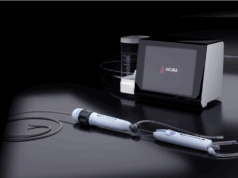Veniti announced on 23 January 2014 that patients in the European Union (EU) were successfully treated for symptomatic venous outflow obstruction of the lower extremities with the Veniti Vici Venous Stent System. These procedures mark the first uses in patients of this novel venous stent from Veniti. More procedures using the Veniti Vici Venous Stent System are scheduled at various locations in the EU, including a live case demonstration at the Leipzig Interventional Course (LINC) on 28 January 2014.
The Veniti Vici Venous Stent was designed from inception to be compatible with the unique anatomy and pathology of the venous system to specifically address the unmet need for a dedicated venous stent. Hundreds of thousands of people around the world suffer from lower-extremity venous disease, and until recently, the only treatment options available involved the use of re-purposed vascular stents originally designed for use in the arterial system, which physicians know is vastly different from the venous system in terms of haemodynamics, physiology, pathophysiology and other important characteristics.
Stephen Black, consultant vascular surgeon at the St George’s Vascular Institute, St George’s Hospital, London, UK, implanted Veniti Vici stents in five patients on 14 and 15 January. “The Veniti Vici venous stent appears to have the radial strength and vein coverage to provide optimal results in patients with symptomatic outflow obstruction of the lower extremities,” said Black. “Having a stent that was designed from its inception for use in veins makes this an important addition to my treatment options.”
Peter Neglen, a pioneer in venous stenting, who was also present at St George’s on 14 and 15 January commented: “The Veniti Vici stent placement today in patients represented the culmination of years of working with venous stent designs to better suit the unique characteristics of the venous anatomy and venous disease.”
Gerard O’Sullivan at the prominent Galway University Hospitals, Galway, Ireland, who implanted the Veniti Vici stent on 16 January also commented that “The Veniti Vici venous stent is a step forward in venous stenting to help treat patients suffering from venous outflow obstruction.”
“We are pleased that the unique advantages of a stent designed specifically for the venous system-including end-to-end crush resistance, higher radial resistive force, flexibility, and continuous vein coverage-are available to physicians treating venous outflow obstructions in the lower extremities,” noted Scott Solano, Veniti president and chief executive officer. “We believe the Veniti Vici stent offers significant patient benefit due to its venous-specific design.”









